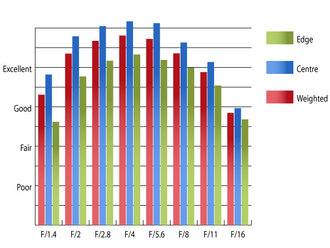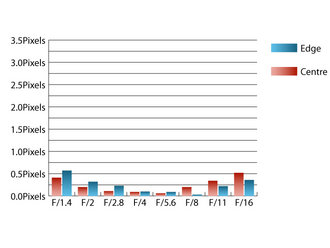Panasonic Leica DG Summilux 25mm f/1.4 ASPH Lens Review
Panasonic Leica DG Summilux f/1.4 ASPH Performance
As far as image sharpness is concerned, this lens puts in a very fine performance, worthy of the Leica name tag. Sharpness in the centre of the image area is already approaching excellent levels at maximum aperture and stopping the lens down a little improves this optic's performance further. Peak sharpness across the frame is achieved by f/4, where the clarity in the centre is outstanding, and excellent towards the edges of the frame. Diffraction starts to take a bite out of the sharpness at smaller apertures, but the lens still performs excellently down to f/11. | How to read our chartsThe blue column represents readings from the centre of the picture frame at the various apertures and the green is from the edges. Averaging them out gives the red weighted column. The scale on the left side is an indication of actual image resolution. The taller the column, the better the lens performance. Simple. For this review, the lens was tested on a Panasonic Lumix G3 using Imatest. |
Chromatic aberrations are very well controlled. At f/1.4 fringing can cover just over half a pixel width towards the edge of the frame. This level will be difficult to spot, even in large prints and harsh crops from near the edge of the frame and it also the worst you will see from this lens.
 | How to read our chartsChromatic aberration is the lens' inability to focus on the sensor or film all colours of visible light at the same point. Severe chromatic aberration gives a noticeable fringing or a halo effect around sharp edges within the picture. It can be cured in software. Apochromatic lenses have special lens elements (aspheric, extra-low dispersion etc) to minimize the problem, hence they usually cost more. For this review, the lens was tested on a Panasonic Lumix G3 using Imatest. |
For a wide aperture lens, falloff of illumination towards the corners is well controlled. At f/1.4 the corners are 1.8 stops darker than the image centre and illumination across the frame is visually uniform by at f/2.8.
Imatest could only detect a minimal level of 0.548% barrel distortion, which should pose no issues for most photographic applications. However if you're super-critical about absolutely straight lines, you'll be glad to know the distortion pattern is uniform across the frame, which should make any necessary corrections easy enough to apply.
The deep rectangular hood, which comes supplied does a sterling job of keeping extraneous light from causing any flare or loss of contrast. Light sources within the frame rarely cause any loss of contrast, except for extreme lighting conditions.
Add your message
Login required
Please login here or if you've not registered, you can register here. Registering is safe, quick and free.
Please login here or if you've not registered, you can register here. Registering is safe, quick and free.
photodo Stats
1102 lenses
428 MTF tests
74 in-depth photodo reviews
100+ users join each day
Help the lens community by reviewing or rating a lens today via our lens search
428 MTF tests
74 in-depth photodo reviews
100+ users join each day
Help the lens community by reviewing or rating a lens today via our lens search
Latest Lens Reviews
- Chinon 28mm f/2.8 Vintage Lens Review
- Canon EF 70-200mm f/4L IS II USM Lens Review
- Samyang AF 85mm f/1.4 EF Review
- Sigma 70mm f/2.8 DG Macro Art Review
- Samyang AF 24mm f/2.8 FE Review
- Meike 50mm f/1.7 Review
- Tamron 70-210mm f/4 Di VC USD Review
- Lensbaby Burnside 35mm f/2.8 Review
- Asahi Super Takumar 50mm f/1.4 Review
- Asahi Super-Multi-Coated Takumar 135mm f/3.5 Review
